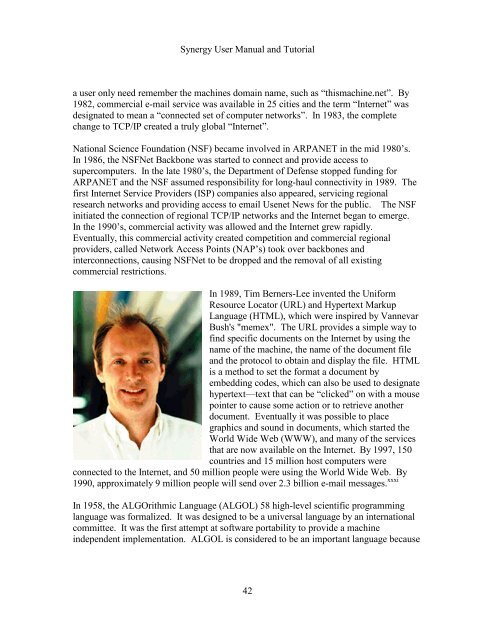Synergy User Manual and Tutorial. - THE CORE MEMORY
Synergy User Manual and Tutorial. - THE CORE MEMORY
Synergy User Manual and Tutorial. - THE CORE MEMORY
You also want an ePaper? Increase the reach of your titles
YUMPU automatically turns print PDFs into web optimized ePapers that Google loves.
<strong>Synergy</strong> <strong>User</strong> <strong>Manual</strong> <strong>and</strong> <strong>Tutorial</strong><br />
a user only need remember the machines domain name, such as “thismachine.net”. By<br />
1982, commercial e-mail service was available in 25 cities <strong>and</strong> the term “Internet” was<br />
designated to mean a “connected set of computer networks”. In 1983, the complete<br />
change to TCP/IP created a truly global “Internet”.<br />
National Science Foundation (NSF) became involved in ARPANET in the mid 1980’s.<br />
In 1986, the NSFNet Backbone was started to connect <strong>and</strong> provide access to<br />
supercomputers. In the late 1980’s, the Department of Defense stopped funding for<br />
ARPANET <strong>and</strong> the NSF assumed responsibility for long-haul connectivity in 1989. The<br />
first Internet Service Providers (ISP) companies also appeared, servicing regional<br />
research networks <strong>and</strong> providing access to email Usenet News for the public. The NSF<br />
initiated the connection of regional TCP/IP networks <strong>and</strong> the Internet began to emerge.<br />
In the 1990’s, commercial activity was allowed <strong>and</strong> the Internet grew rapidly.<br />
Eventually, this commercial activity created competition <strong>and</strong> commercial regional<br />
providers, called Network Access Points (NAP’s) took over backbones <strong>and</strong><br />
interconnections, causing NSFNet to be dropped <strong>and</strong> the removal of all existing<br />
commercial restrictions.<br />
In 1989, Tim Berners-Lee invented the Uniform<br />
Resource Locator (URL) <strong>and</strong> Hypertext Markup<br />
Language (HTML), which were inspired by Vannevar<br />
Bush's "memex". The URL provides a simple way to<br />
find specific documents on the Internet by using the<br />
name of the machine, the name of the document file<br />
<strong>and</strong> the protocol to obtain <strong>and</strong> display the file. HTML<br />
is a method to set the format a document by<br />
embedding codes, which can also be used to designate<br />
hypertext—text that can be “clicked” on with a mouse<br />
pointer to cause some action or to retrieve another<br />
document. Eventually it was possible to place<br />
graphics <strong>and</strong> sound in documents, which started the<br />
World Wide Web (WWW), <strong>and</strong> many of the services<br />
that are now available on the Internet. By 1997, 150<br />
countries <strong>and</strong> 15 million host computers were<br />
connected to the Internet, <strong>and</strong> 50 million people were using the World Wide Web. By<br />
1990, approximately 9 million people will send over 2.3 billion e-mail messages. xxxi<br />
In 1958, the ALGOrithmic Language (ALGOL) 58 high-level scientific programming<br />
language was formalized. It was designed to be a universal language by an international<br />
committee. It was the first attempt at software portability to provide a machine<br />
independent implementation. ALGOL is considered to be an important language because<br />
42

















